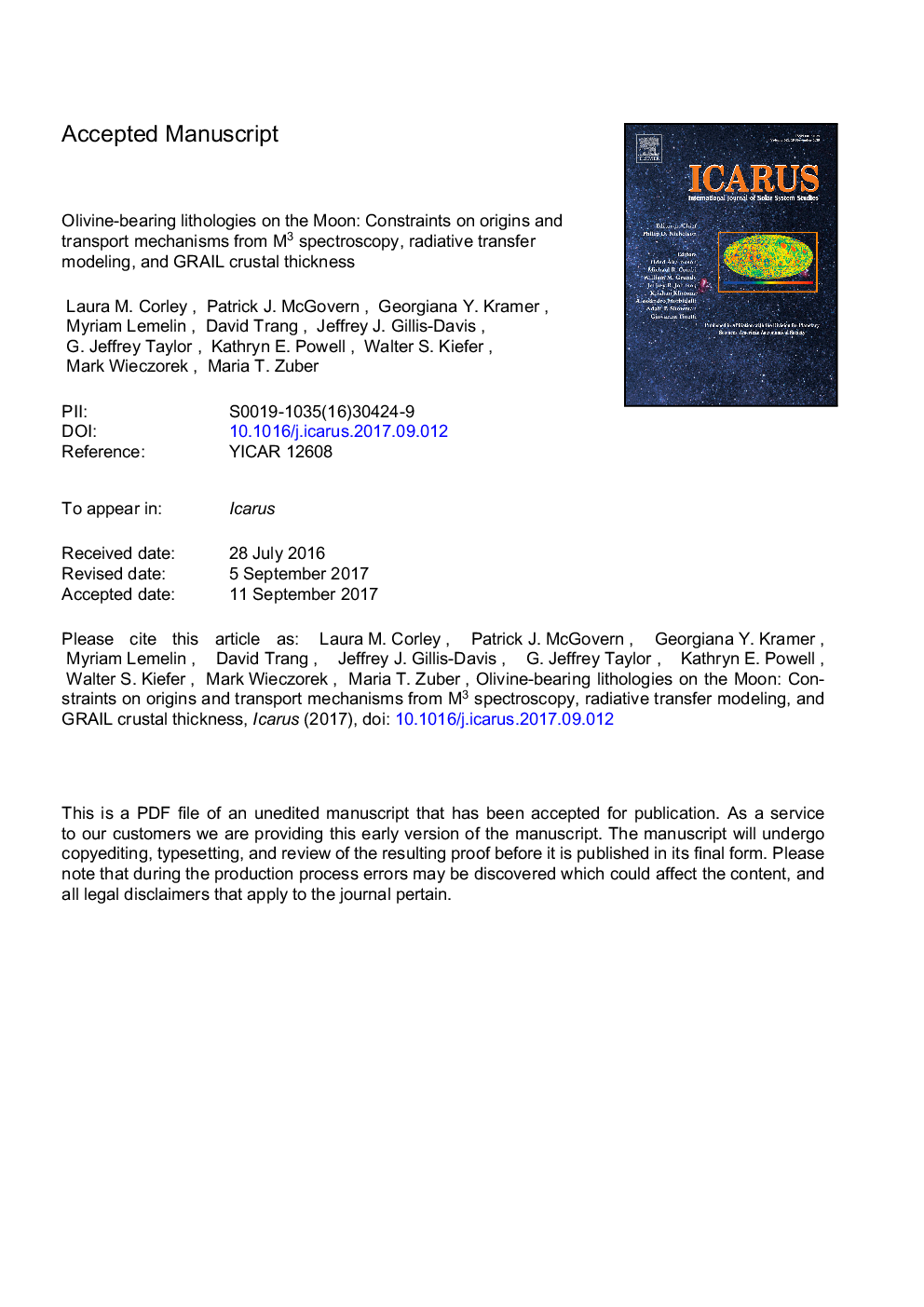| کد مقاله | کد نشریه | سال انتشار | مقاله انگلیسی | نسخه تمام متن |
|---|---|---|---|---|
| 5486950 | 1523491 | 2018 | 68 صفحه PDF | دانلود رایگان |
عنوان انگلیسی مقاله ISI
Olivine-bearing lithologies on the Moon: Constraints on origins and transport mechanisms from M3 spectroscopy, radiative transfer modeling, and GRAIL crustal thickness
دانلود مقاله + سفارش ترجمه
دانلود مقاله ISI انگلیسی
رایگان برای ایرانیان
کلمات کلیدی
موضوعات مرتبط
مهندسی و علوم پایه
علوم زمین و سیارات
علوم فضا و نجوم
پیش نمایش صفحه اول مقاله

چکیده انگلیسی
High-resolution hyperspectral data from Chandrayaan-1's Moon Mineralogy Mapper (M3) allow detection of olivine on the lunar surface. Olivine exposed at the surface may originate as mantle material or igneous products (intrusive or extrusive). Potential transport mechanisms include excavation of the mantle or lower crustal material by impacts that form basins and complex craters, differentiation of impact melt sheets, or magmatic emplacement of lavas, cumulates, or xenoliths. A sample of the lunar mantle, which has not been conclusively identified in the lunar sample collection, would yield fundamental new insights into the composition, structure, and evolution of the lunar interior. Olivine identified in remote spectral data is generally accepted to originate from the primary mantle, because abundant olivine is expected to exist in the mantle and lower crust, yet have sparse occurrences in the upper crust. In this study, we identified 111 M3 single-pixel spectra with characteristic absorption features consistent with olivine at Crisium, Nectaris, and Humorum basins and near the craters Roche and Tsiolkovsky. In an effort to determine the origins and transport mechanisms that led to these individual exposures, we estimated mineral abundances using radiative transfer modeling and examined crustal thickness estimates, topography and slope maps, and images from the Lunar Reconnaissance Orbiter Camera (LROC). At Crisium basin, where crustal thickness is near 0â¯km (Wieczorek et al., 2013), mantle olivine may have been exposed by basin-forming impact and deposited on the rim. Picard crater, which is superposed on the floor of Crisium, also exhibits potential mantle olivine in its ejecta. Within Nectaris basin, olivine exposures are confined to the rims of small craters on the mare, which are inferred to excavate a layer of olivine-rich mare basalt. Olivine occurrences on the rim of Humorum basin, including those located on a graben, are likely to be cumulates of shallow intrusions that were transported magmatically to the surface. Near Roche crater, olivine may have originated in shallow dikes that reached the subsurface and were exposed by impacts. In addition to verifying both known and previously unidentified olivine exposures, our combined geophysical, spectral, and radiative transfer modeling investigation has allowed identification of both igneous and mantle-derived olivine.
ناشر
Database: Elsevier - ScienceDirect (ساینس دایرکت)
Journal: Icarus - Volume 300, 15 January 2018, Pages 287-304
Journal: Icarus - Volume 300, 15 January 2018, Pages 287-304
نویسندگان
Laura M. Corley, Patrick J. McGovern, Georgiana Y. Kramer, Myriam Lemelin, David Trang, Jeffrey J. Gillis-Davis, G. Jeffrey Taylor, Kathryn E. Powell, Walter S. Kiefer, Mark Wieczorek, Maria T. Zuber,